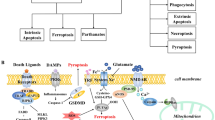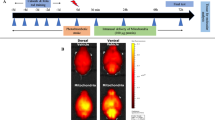Abstract
Ischaemic stroke is one of the most common causes of mortality and morbidity.circDlgap4 has been implicated in ischemia/reperfusion injury through an unknown mechanism. Here, we studied the function of circDlgap4/AUF1 in ischaemic stroke and its underlying molecular mechanism. N2a cells and primary mouse cortical neurons were subjected to OGD to mimic neuronal injury during ischemia. BV-2 cells were treated with LPS to mimic neuroinflammation. The MTT assay was used to assess cell viability, while flow cytometry was used to measure cell apoptosis. qRT–PCR, western blotting, immunohistochemistry, and immunostaining were employed to determine the levels of circDlgap4, AUF1, NRF2/HO-1, proinflammatory cytokines, NF-κB pathway–related proteins, and IBA-1. RIP and RNA pulldown assays were employed to validate the interactions of circDlgap4/AUF1, AUF1/NRF2, and AUF1/cytokine mRNAs. mRNA degradation was used to determine the effects on mRNA stability. The tMCAO model was used as an in vivo model of ischaemic stroke. TCC staining and neurological scoring were performed to evaluate ischaemic injury. circDlgap4 was decreased following OGD and during tMCAO. circDlgap4 overexpression inhibited OGD-induced cell death and oxidative stress and LPS-induced increases in proinflammatory cytokines by increasing NRF2/HO-1. Knockdown of AUF1 blocked the effects of circDlgap4 overexpression. Mechanistically, RIP, RNA pulldown, and mRNA degradation assay results showed circDlgap4/AUF1/NRF2 mRNA formed a complex to stabilize NRF2 mRNA. Furthermore, AUF1 directly interacted with TNF-α, IL-1β, and COX-2 mRNAs, and circDlgap4/AUF1 binding promoted the degradation of these mRNAs. Finally, circDlgap4 ameliorated ischaemic injury in vivo. circDlgap4 alleviates ischaemic stroke injury by suppressing oxidative stress and neuroinflammation by binding to AUF1.







Similar content being viewed by others
Data Availability
All data generated or analyzed during this study are included in this published article.
Abbreviations
- circRNAs:
-
Circular RNAs
- AUF1:
-
AU-rich element RNA-binding protein 1
- DMEM:
-
Dulbecco’s modified Eagle medium
- OGD:
-
Oxygen and glucose deprivation
- LPS:
-
Lipopolysaccharide
- PI:
-
Propidium iodide
- ELISA:
-
Enzyme-linked immunosorbent assay
- RIP:
-
RNA Immunoprecipitation
- tMCAO :
-
Transient middle cerebral artery occlusion
- TTC:
-
Triphenyltetrazolium chloride
- ROS:
-
Reactive oxygen species
References
Lee RHC, Lee MHH, Wu CYC, Couto ESA, Possoit HE, Hsieh TH, Minagar A, Lin HW (2018) Cerebral ischemia and neuroregeneration. Neural Regen Res 13(3):373–385. https://doi.org/10.4103/1673-5374.228711
Soler EP, Ruiz VC (2010) Epidemiology and risk factors of cerebral ischemia and ischemic heart diseases: similarities and differences. Curr Cardiol Rev 6(3):138–149. https://doi.org/10.2174/157340310791658785
Chen H, Yoshioka H, Kim GS, Jung JE, Okami N, Sakata H, Maier CM, Narasimhan P, Goeders CE, Chan PH (2011) Oxidative stress in ischemic brain damage: mechanisms of cell death and potential molecular targets for neuroprotection. Antioxid Redox Signal 14(8):1505–1517. https://doi.org/10.1089/ars.2010.3576
Kawabori M, Yenari MA (2015) Inflammatory responses in brain ischemia. Curr Med Chem 22(10):1258–1277. https://doi.org/10.2174/0929867322666150209154036
Barrett SP, Salzman J (2016) Circular RNAs: analysis, expression and potential functions. Development 143(11):1838–1847. https://doi.org/10.1242/dev.128074
Haddad G, Lorenzen JM (2019) Biogenesis and function of circular RNAs in Health and in disease. Front Pharmacol 10:428. https://doi.org/10.3389/fphar.2019.00428
Yang J, Chen M, Cao RY, Li Q, Zhu F (2018) The role of circular RNAs in cerebral ischemic diseases: ischemic stroke and cerebral ischemia/reperfusion injury. Adv Exp Med Biol 1087:309–325. https://doi.org/10.1007/978-981-13-1426-1_25
Wu F, Han B, Wu S, Yang L, Leng S, Li M, Liao J, Wang G, Ye Q, Zhang Y, Chen H, Chen X, Zhong M, Xu Y, Liu Q, Zhang JH, Yao H (2019) Circular RNA TLK1 aggravates neuronal injury and neurological deficits after ischemic stroke via miR-335-3p/TIPARP. J Neurosci 39(37):7369–7393. https://doi.org/10.1523/JNEUROSCI.0299-19.2019
Bai Y, Zhang Y, Han B, Yang L, Chen X, Huang R, Wu F, Chao J, Liu P, Hu G, Zhang JH, Yao H (2018) Circular RNA DLGAP4 ameliorates ischemic stroke outcomes by targeting miR-143 to regulate endothelial-mesenchymal transition associated with blood-brain barrier integrity. J Neurosci 38(1):32–50. https://doi.org/10.1523/JNEUROSCI.1348-17.2017
White EJ, Matsangos AE, Wilson GM (2017) AUF1 regulation of coding and noncoding RNA. Wiley Interdiscip Rev RNA 8 (2). https://doi.org/10.1002/wrna.1393
Gratacos FM, Brewer G (2010) The role of AUF1 in regulated mRNA decay. Wiley Interdiscip Rev RNA 1(3):457–473. https://doi.org/10.1002/wrna.26
Zhou YF, Li YN, Jin HJ, Wu JH, He QW, Wang XX, Lei H, Hu B (2018) Sema4D/PlexinB1 inhibition ameliorates blood-brain barrier damage and improves outcome after stroke in rats. FASEB J 32(4):2181–2196. https://doi.org/10.1096/fj.201700786RR
Lu JY, Sadri N, Schneider RJ (2006) Endotoxic shock in AUF1 knockout mice mediated by failure to degrade proinflammatory cytokine mRNAs. Genes Dev 20(22):3174–3184. https://doi.org/10.1101/gad.1467606
Poganik JR, Long MJC, Disare MT, Liu X, Chang SH, Hla T, Aye Y (2019) Post-transcriptional regulation of Nrf2-mRNA by the mRNA-binding proteins HuR and AUF1. FASEB J 33(12):14636–14652. https://doi.org/10.1096/fj.201901930R
Tan HL, Chiu SL, Zhu Q, Huganir RL (2020) GRIP1 regulates synaptic plasticity and learning and memory. Proc Natl Acad Sci U S A 117(40):25085–25091. https://doi.org/10.1073/pnas.2014827117
Tan HL, Queenan BN, Huganir RL (2015) GRIP1 is required for homeostatic regulation of AMPAR trafficking. Proc Natl Acad Sci U S A 112(32):10026–10031. https://doi.org/10.1073/pnas.1512786112
Huang M, Cheng G, Tan H, Qin R, Zou Y, Wang Y, Zhang Y (2017) Capsaicin protects cortical neurons against ischemia/reperfusion injury via down-regulating NMDA receptors. Exp Neurol 295:66–76. https://doi.org/10.1016/j.expneurol.2017.05.001
Li Y, Chopp M, Chen J, Wang L, Gautam SC, Xu YX, Zhang Z (2000) Intrastriatal transplantation of bone marrow nonhematopoietic cells improves functional recovery after stroke in adult mice. J Cereb Blood Flow Metab 20(9):1311–1319. https://doi.org/10.1097/00004647-200009000-00006
Li W, Yang S (2016) Targeting oxidative stress for the treatment of ischemic stroke: upstream and downstream therapeutic strategies. Brain Circ 2(4):153–163. https://doi.org/10.4103/2394-8108.195279
Favate AS, Younger DS (2016) Epidemiology of Ischemic Stroke. Neurol Clin 34(4):967–980. https://doi.org/10.1016/j.ncl.2016.06.013
Khoshnam SE, Winlow W, Farzaneh M, Farbood Y, Moghaddam HF (2017) Pathogenic mechanisms following ischemic stroke. Neurol Sci 38(7):1167–1186. https://doi.org/10.1007/s10072-017-2938-1
Radak D, Resanovic I, Isenovic ER (2014) Link between oxidative stress and acute brain ischemia. Angiology 65(8):667–676. https://doi.org/10.1177/0003319713506516
Kofler J, Hurn PD, Traystman RJ (2005) SOD1 overexpression and female sex exhibit region-specific neuroprotection after global cerebral ischemia due to cardiac arrest. J Cereb Blood Flow Metab 25(9):1130–1137. https://doi.org/10.1038/sj.jcbfm.9600119
Jayaraj RL, Azimullah S, Beiram R, Jalal FY, Rosenberg GA (2019) Neuroinflammation: friend and foe for ischemic stroke. J Neuroinflammation 16(1):142. https://doi.org/10.1186/s12974-019-1516-2
Wang S, Chen J, Yu W, Deng F (2019) Circular RNA DLGAP4 ameliorates cardiomyocyte apoptosis through regulating BCL2 via targeting miR-143 in myocardial ischemia-reperfusion injury. Int J Cardiol 279:147. https://doi.org/10.1016/j.ijcard.2018.09.023
Wang Y, Zhao R, Liu W, Wang Z, Rong J, Long X, Liu Z, Ge J, Shi B (2019) Exosomal circHIPK3 released from hypoxia-pretreated cardiomyocytes regulates oxidative damage in cardiac microvascular endothelial cells via the miR-29a/IGF-1 pathway. Oxid Med Cell Longev 2019:7954657. https://doi.org/10.1155/2019/7954657
Fischer JW, Leung AK (2017) CircRNAs: a regulator of cellular stress. Crit Rev Biochem Mol Biol 52(2):220–233. https://doi.org/10.1080/10409238.2016.1276882
Zhou Z, Sun B, Huang S, Zhao L (2019) Roles of circular RNAs in immune regulation and autoimmune diseases. Cell Death Dis 10(7):503. https://doi.org/10.1038/s41419-019-1744-5
Xu Y, Wu W, Han Q, Wang Y, Li C, Zhang P, Xu H (2019) New insights into the interplay between non-coding RNAs and RNA-binding protein HnRNPK in regulating cellular functions. Cells 8 (1). https://doi.org/10.3390/cells8010062
Kim C, Kang D, Lee EK, Lee JS (2017) Long Noncoding RNAs and RNA-binding proteins in oxidative stress, cellular senescence, and age-related diseases. Oxid Med Cell Longev 2017:2062384. https://doi.org/10.1155/2017/2062384
Zhang L, Yang Z, Trottier J, Barbier O, Wang L (2017) Long noncoding RNA MEG3 induces cholestatic liver injury by interaction with PTBP1 to facilitate shp mRNA decay. Hepatology 65(2):604–615. https://doi.org/10.1002/hep.28882
Moore AE, Chenette DM, Larkin LC, Schneider RJ (2014) Physiological networks and disease functions of RNA-binding protein AUF1. Wiley Interdiscip Rev RNA 5(4):549–564. https://doi.org/10.1002/wrna.1230
Garcia-Maurino SM, Rivero-Rodriguez F, Velazquez-Cruz A, Hernandez-Vellisca M, Diaz-Quintana A, De la Rosa MA, Diaz-Moreno I (2017) RNA binding protein regulation and cross-talk in the control of AU-rich mRNA fate. Front Mol Biosci 4:71. https://doi.org/10.3389/fmolb.2017.00071
Acknowledgements
Thanks to the members of our laboratory for their contributions.
Funding
This work was supported by the National Natural Science Foundation of China (81671296).
Author information
Authors and Affiliations
Contributions
HL: methodology, data curation, visualization, investigation, validation, writing—original draft preparation; WZ: methodology, software, investigation; ZS: supervision, conceptualization, writing—reviewing and editing.
Corresponding author
Ethics declarations
Ethics
All animal experiments and protocol have been approved by the Animal Care and Use Committee of the Third Xiangya Hospital of Central South University.
Consent for Publication
The informed consent obtained from study participants.
Competing Interests
The authors declare no competing interests.
Additional information
Publisher's Note
Springer Nature remains neutral with regard to jurisdictional claims in published maps and institutional affiliations.
Rights and permissions
About this article
Cite this article
Liu, H., Zheng, W. & Song, Z. circDlgap4 Alleviates Cerebral Ischaemic Injury by Binding to AUF1 to Suppress Oxidative Stress and Neuroinflammation. Mol Neurobiol 59, 3218–3232 (2022). https://doi.org/10.1007/s12035-022-02796-5
Received:
Accepted:
Published:
Issue Date:
DOI: https://doi.org/10.1007/s12035-022-02796-5




